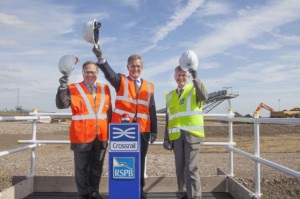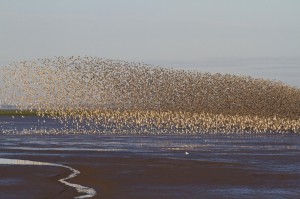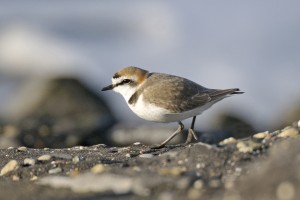
Last week Environment Secretary Owen Paterson launched work on Europe’s largest man-made wetland nature reserve – at least so say the RSPB and Crossrail whereas Defra is noticeably silent on the matter. Luckily, there is photographic evidence of the event.
In an amazingly complex and difficult project, for which the RSPB’s Chief Executive Mike Clarke deserves great credit, thousands of tonnes of soil which are currently under London will have coastal waders like knot running around on them in a few years time.
For an engineering project like Crossrail, digging out a tunnel leaves you with the problem of where to put the soil. Having rejected a ‘Great Escape’ type of solution involving Boris Johnson criss-crossing London on his bike letting the soil out of his trouser bottoms, Crossrail were delighted to find that the RSPB had a suitable site that needed a few more inches of height. 4.5 million tonnes of soil will be moved to the Essex coast at Wallasea Island to help construction of a new coastal wetland from an existing area of reclaimed farmland.
 Environment Secretary Owen Paterson said: “The excellent work that Crossrail and the RSPB are doing to create the Jubilee Marshes at Wallasea shows how major infrastructure schemes can help to generate economic growth as well as helping to improve local wildlife. This could be the gold standard against which all future projects are measured.”
Environment Secretary Owen Paterson said: “The excellent work that Crossrail and the RSPB are doing to create the Jubilee Marshes at Wallasea shows how major infrastructure schemes can help to generate economic growth as well as helping to improve local wildlife. This could be the gold standard against which all future projects are measured.”
Mike Clarke, Chief Executive of the RSPB said: “This is the largest coastal habitat creation of its kind in Europe and it will transform an area more than double the size of the City of London back to the coastal marshland it once was. Wallasea Island will show for the first time on a large scale, how it’s possible to ‘future proof’ low lying coasts against sea level rise caused by climate change. This will deliver benefits to wildlife and provide a wonderful place for people to enjoy. Wallasea Island could now see the return of birds that once bred in England, such as Kentish plovers that were last seen here more than 50 years ago.”

Crossrail Chief Executive Andrew Wolstenholme said: “This landmark project is a pioneering example of how the construction industry and environment groups can work in partnership to build a sustainable Britain that benefits both the economy and the environment. Crossrail is delighted to be involved in a project that will leave a lasting legacy long after the construction of the new rail line has been completed.”
Because of sea level rise (aided by the coast bouncing back after the Ice Age) saltmarsh in southeast England is being eaten away. Government has set a recreation target of 3600ha of saltmarsh and mudflat by 2015 – 670ha of this will be produced at Wallasea.
Instead of habitat being lost due to sea level rise caused by climate change, it is hoped that the habitat created through this project will provide a home for southern species such as Kentish plovers that may spread north because of climate change as well as masses of wintering and passage waders.
[registration_form]
Good to see they moving the soil by boat rather than thousands of trucks
Sue – welcome and thank you for your comment
Mark, did you hear the BBC Radio 4 coverage of this on the Today programme earlier this week? They interviewed a researcher who presented evidence about the floristic diversity of newly created wetlands being much poorer than in original habitats (particularly for saltmarsh). My ears pricked up because it sounded like a sensible discussion of the science. They then drooped because this could easily be twisted either into a positive message about how nature conservation is a subtle complex and long term process that needs careful attention and proper funding or a negative one that it just doesn’t work anyway. I felt the implicit messages veered towards the latter – and that we could have done with more detail on all sorts of things like timescales, which species etc. etc.
Anyway it came across as a bit of a damper and given the general enthusiasm for and apparent (to the interested but uninitiated bystander) success of wetland habitat creation, rather surprising. My pretty basic understanding is that you only get flocks of birds if the mud is seething with life.
Any comments?
I don’t know enough about wetland creation to be able to judge this. Any comment?
Susan – in brief, I would say it is better not to lose habitats in the first place. But if we do, then putting them back is a good idea. It may well be that it takes a while, maybe a long while, for all aspects of the ecosystem to be restored but that just means that we should start now, learn from what we do and be patient. Birds are relatively easy and there are lots of examples of successful wetland recreation – you wouldn’t get bitterns at Lakenheath, for example, if there were nothing for them to eat there so there must be a fairly thriving wetland community, I would say.
Yes, that’s what I thought too., from my position of considerably greater ignorance. It would have been good if that pretty straightforward message had come across more clearly on the radio.
Susan – I didn’t hear the radio piece but I have sympathy for anyone who doesn’t get all their message across – I’ve done it loads of times!
I think it is fair to say that wetlands (generally speaking) are, in relative terms, simpler to restore/recreate than terrestrial habitats such as species-rich grassland, heathlands and woodlands, certainly in the context of relative timescales.
Apart from obvious site related factors, perhaps the most important requirements of habitat restoration and creation are patience and long-term vision. Also an acceptance that these habitats are unlikely to mature or reach their full potential in our life-time, or that of our grandchildren or indeed that of our grandchildren’s grandchildren. Sadly too few politicians (and many conservationists) seem to think this way.
Joe W – well said.
“aided by the coast bouncing back after the Ice Age”
In the North and West – South and East tilting down
Which is why the process has contributed to loss of salt marsh (and coastal erosion in general) on the East coast.
I believe geological correctnessness demands the use of “isostatic adjustment” – to acknowledge the 3-D nature of land surface movements.
The consequences are also seen in the Hampshire basin. Goodbye, Barton-on-Sea …
In reference to Susan’s comment, the bloke on Radio4, was also on our local news Mark (Look East) as he was from the University of East Anglia and was commenting on a VERY long report on a man made salt marsh that sat next natural salt marsh in Essex. So they were able to do direct comparison. The results were very negative fo flora,invertrebates (I think I spetl that wrong) and BIRDS. It also comes down pretty hard on different agencies and the lack of co-operation between Landowners,Government agencies and “certain” conservation agencies.
This new project is needed for the reason you have described Mark, but like I’ve already said on Birdguides there are certain things that concern mainly the timing of the announcenment just as Nick Clegg last week said ” a third runway at Heathrow is uneconomical and enviromentally unstainable” and the Lib/Dems voted at the party conference to also make it a policy to support no more airport expansion in the South East. Please read again what the Enviroment secretary siad in this post and to me that sends shivers down my spine…
Spot on. Mark mentioned Boris – an association of ideas – “Island”, perhaps?
It’s great that something imaginative and positive is being done with the spoil from the Crossrail project, but I’m a tad troubled by Dr Clarke’s assertion that “Wallasea Island will show for the first time on a large scale, how it’s possible to ‘future proof’ low lying coasts against sea level rise caused by climate change.”
What does he mean by future? Why does he refer only to climate change? Whatever happened to plate tectonics? Has he heard of Cnut? Does he envisage a constant supply of mega-scale civil infrastructure projects to create more dirt, and prove Will Rogers wrong? Has he got designs on the arisings from HS2?
I think the article mentioned above is this piece of research in the Journal of Applied Ecology: “Does managed coastal realignment create saltmarshes with ‘equivalent biological characteristics’ to natural reference sites?”
Here’s a link to the summary page and where can also read the full article.
http://onlinelibrary.wiley.com/doi/10.1111/j.1365-2664.2012.02198.x/abstract
Richard – thank you.
In my opinion, the UEA boffins were rather selective in the example they chose. Many of the early realignment schemes suffered because of the difference in land levels between the newly created and old saltmarshes (which is why all that material is being imported to Wallasea) or because there was not enough variation in topography on the realignment sites.
Had they used Freiston Shore in Lincolnshire as an example they would have been able to tell people how successful managed realignment can be. At this site, within five years of breaching the sea walls, the newly created saltmarsh had the same floristic diversity as the long-established saltmarsh. Maybe they didn’t want to use this example as Cambridge University did the monitoring of the scheme…
Rob, I’d imagine it was probably something to do with whichever researchers at Cambridge were behind the monitoring of that site are the ones with the rights to publish that data (although of course the UEA researchers could mention that other sites seem different to theirs). Assuming the UEA research was careful in its methodology it is still a valid example, but it is of course only 1 example and can’t be generalised to all recreated wetlands, just as the Cambridge research can’t either.
In my research department (Stirling) there is a PhD student doing similar work, but across several paired recreated and natural salt marsh sites across the UK looking at plant biodiversity, but also the genetic diversity within key salt marsh plant species. It is too early for results yet, but it will be interesting to see what he finds.